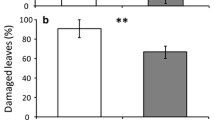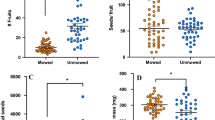Abstract
While herbivores can have a wide range of impacts on their host plants, instances in which herbivore damage is truly beneficial are rare. Thus, it was surprising that damage by the potato stalk borer (PSB) was associated with increased fitness of its native host plant (horsenettle) in a recent field study, particularly because this insect can have such severe negative effects on potato crops. A controlled experiment with potted horsenettle was conducted to investigate the impact of damage by PSB to see if it has any negative impacts on the plants, or whether horsenettle truly overcompensates for its damage. Damage by PSB had negligible impact on sexual reproduction and potential future vegetative propagation through root production in this experiment. Additionally, PSB damage did not exacerbate the negative fitness impact of heavy leaf damage by the eggplant lace bug. The lack of positive impacts in the potted horsenettle study suggests that selection for decreased resistance to PSB in the field study was due to correlated selection for increased plant vigor, rather than to overcompensation. That is, when given options, PSB females may preferentially oviposit on larger, healthier plants that are likely to be better hosts for their larvae. An important implication of these results is that a wild weed’s high tolerance of a natural herbivore can compound the weed’s potential to serve as a reservoir from which the herbivore can switch to closely related agricultural plants that are not tolerant of its damage.




Similar content being viewed by others
References
Agrawal AA (2000) Overcompensation of plants in response to herbivory and the by-product benefits of mutualism. Trends Plant Sci 5:309–313
Agrawal AA (2011) Current trends in the evolutionary ecology of plant defence. Funct Ecol 25:420–432
Bassett IJ, Munro DB (1986) The biology of Canadian weeds. 78. Solanum carolinense L. and Solanum rostratum Dunal. Can J Plant Sci 66:977–991
Brust GE (2010) Squash vine borer (Lepidoptera: Sesiidae) management in pumpkin in the mid-Atlantic. J Appl Entomol 134:781–788
Crawley MJ (1999) Herbivory. In: Press MC, Scholes JD, Barker MG (eds) Physiological plant ecology. Blackwell Science Ltd., Oxford, pp 199–217
Cuda JP, Burke HR (1986) Reproduction and development of the potato stalk borer, (Coleoptera: Curculionidae) with notes on field biology. J Econ Entomol 79:1548–1554
Elle E (1998) The quantitative genetics of sex allocation in the andromonoecious perennial Solanum carolinense (L.). Heredity 80:481–488
Faville EE, Parrott PJ (1899) The potato stalk weevil. Trans Kans Acad Sci 4:1–12
Fournier V, Rosenheim JA, Brodeur J, Diez JM, Johnson MW (2006) Multiple plant exploiters on a shared host: testing for nonadditive effects on plant performance. Ecol Appl 16:2382–2398
Frank JR (1990) Influence of horsenettle (Solanum carolinense) on snapbean (Phaseolus vulgaris). Weed Sci 38:220–223
Fritz RS, Crabb BA, Hochwender CG (2000) Preference and performance of a gall-inducing sawfly: a test of the plant vigor hypothesis. Oikos 89:555–563
Hackett NM, Murray DS, Weeks DL (1987) Interference of horsenettle (Solanum carolinense) with peanuts (Arachis hypogaea). Weed Sci 35:780–784
Hendrix SD (1988) Herbivory and its impact on plant reproduction. In: Lovett Doust J, Lovett Doust L (eds) Plant reproductive ecology: patterns and strategies. Oxford University Press, New York, pp 246–263
Ilnicki RD, Tisdell TF, Fertig SN, Furrer AH Jr (1962) Life history studies as related to weed control in the Northeast -- horse nettle. Agricultural Experimental Station, University of Rhode Island, Kingston
Imura O (2003) Herbivorous arthropod community of an alien weed Solanum carolinense L. Appl Entomol Zool 38:293–300
Kutywayo D, Chemura A, Kusena W, Chidoko P, Mahoya C (2013) The impact of climate change on the potential distribution of agricultural pests: the case of the coffee white stem borer (Monochamus leuconotus P.) in Zimbabwe. PLoS ONE 8:e73432
Lennartsson T, Nilsson P, Tuomi J (1998) Induction of overcompensation in the field gentian, Gentianella campestris (Gentianaceae). Ecology 79:1061–1072
Lesieur V et al (2016) Phylogeography of the wheat stem sawfly, Cephus cinctus Norton (Hymenoptera: Cephidae): implications for pest management. PLoS ONE 11:e0168370
Loeb MLG (2003) Evolution of egg dumping in a subsocial insect. Am Nat 161:129–142
Manikandan N, Kennedy JS, Geethalakshmi V (2016) Effect of elevated temperature on life-history parameters of rice yellow stem borer (Scirpophaga incertulas Walker). Curr Sci 110:851–857
Michaud JP, Grant AK, Jyoti JL (2007) Impact of the stem borer, Dectes texanus, on yield of the cultivated sunflower, Helianthus annuus. J Insect Sci 7:21
Myers JH (1985) Effect of physiological condition of the host plant on the ovipositional choice of the cabbage white butterfly, Pieris rapae. J Anim Ecol 54:193–204
Nichols RL, Cardina J, Gaines TP (1991) Growth, reproduction and chemical composition of horsenettle (Solanum carolinense). Weed Technol 5:513–520
Nyukuri RW, Kirui SC, Cheramgoi E, Chirchir E, Mwale R (2014) Damage of stem borer species to Zea mays L., Sorghum bicolor L. and three refugia graminae. Afr J Food Sci Technol 5:37–45
Olejniczak P (2011) Overcompensation in response to simulated herbivory in the perennial herb Sedum maximum. Plant Ecol 212:1927–1935
Paige KN, Whitham TG (1987) Overcompensation in response to mammalian herbivory: the advantage of being eaten. Am Nat 129:407–416
Pilson D, Decker KL (2002) Compensation for herbivory in wild sunflower: response to simulated damage by the head-clipping weevil. Ecology 83:3097–3107
Preisser EL, Bastow JL (2005) Plant damage from and defenses against ‘cryptic’ herbivory: a guild perspective. J Plant Int 1:197–210
Price PW (1991) The plant vigor hypothesis and herbivore attack. Oikos 62:244–251
Puentes A, Ågren J (2012) Additive and non-additive effects of simulated leaf and inflorescence damage on survival, growth and reproduction of the perennial herb Arabidopsis lyrata. Oecologia 169:1033–1042
Rathcke BJ (1976) Insect-plant patterns and relationships in the stem-boring guild. Am Midl Nat 96:98–117
Rautio P, Huhta A-P, Piippo S, Tuomi J, Juenger T, Saari M, Aspi J (2005) Overcompensation and adaptive plasticity of apical dominance in Erysimum strictum (Brassicaceae) in response to simulated browsing and resource availability. Oikos 111:179–191
Rice ME, Davis P (2010) Stalk borer (Lepidoptera: Noctuidae) ecology and integrated pest management in corn. J Integr Pest Manag. https://doi.org/10.1603/IPM10006
Rosenthal JP, Kotanen PM (1994) Terrestrial plant tolerance to herbivory. Trends Ecol Evol 9:145–148
Rosenthal JP, Welter SC (1995) Tolerance to herbivory by a stemboring caterpillar in architecturally distinct maizes and wild relatives. Oecologia 102:146–155
Scholes DR, Paige KN (2011) Chromosomal plasticity: mitigating the impacts of herbivory. Ecology 92:1691–1698
Scholes DR, Siddappaji MH, Paige KN (2013) The genetic basis of overcompensation in plants: a synthesis. Int J Mod Bot 3:34–42
Simms EL, Triplett J (1994) Costs and benefits of plant responses to disease: resistance and tolerance. Evolution 48:1973–1985
Smith JB (1895) Cut-worms, the sinuate pear-borer, the potato stalk-borer: bisulphide of carbon as an insecticide. New Jersey Agricultural College Experiment Station, New Brunswick, NJ
Somes MP (1916) Some insects of Solanum carolinense L., and their economic relations. J Econ Entomol 9:39–44
Stowe KA, Marquis RJ, Hochwender CG, Simms EL (2000) The evolutionary ecology of tolerance to consumer damage. Annu Rev Ecol Syst 31:565–595
Strauss SY (1991) Direct, indirect, and cumulative effects of three native herbivores on a shared host plant. Ecology 72:543–558
Strauss SY, Murch P (2004) Towards an understanding of the mechanisms of tolerance: compensating for herbivore damage by enhancing a mutualism. Ecol Entomol 29:234–239
Strauss SY, Sahli HF, Conner JK (2005) Toward a more trait-centered approach to diffuse (co)evolution. New Phytol 165:81–90
Tallamy DW, Denno RF (1982) Life history trade-offs in Gargaphia solani (Hemiptera: Tingidae): the cost of reproduction. Ecology 63:616–620
Tiffin P (2000) Mechanisms of tolerance to herbivore damage: what do we know? Evol Ecol 14:523–536
Tito R, Castellani T, Fáveri SB, Lopes BC, Vasconcelos HL (2016) From over to undercompensation: variable responses to herbivory during ontogeny of a neotropical monocarpic plant. Biotropica 48:608–617
van Emden HF (2013) Handbook of agricultural entomology. Wiley, West Sussex
Wise MJ (2007a) Evolutionary ecology of resistance to herbivory: an investigation of potential genetic constraints in the multiple-herbivore community of Solanum carolinense. New Phytol 175:773–784
Wise MJ (2007b) The herbivores of horsenettle, Solanum carolinense, in northern Virginia: natural history and damage assessment. Southeast Nat 6:505–522
Wise MJ (2010) Diffuse interactions between two herbivores and constraints on the evolution of resistance in horsenettle (Solanum carolinense). Arthropod-Plant Interact 4:159–164
Wise MJ, Abrahamson WG (2007) Effects of resource availability on tolerance of herbivory: a review and assessment of three opposing models. Am Nat 169:443–454
Wise MJ, Cummins JJ (2002) Nonfruiting hermaphroditic flowers as reserve ovaries in Solanum carolinense. Am Midl Nat 148:236–245
Wise MJ, Cummins JJ (2006) Strategies of Solanum carolinense for regulating maternal investment in response to foliar and floral herbivory. J Ecol 94:629–636
Wise MJ, Cummins JJ (2007) Herbivory as an agent of natural selection for floral-sex ratio in horsenettle (Solanum carolinense). Evol Ecol Res 9:1319–1328
Wise MJ, Hébert JB (2010) Herbivores exert natural selection for floral-sex ratio in a field population of horsenettle, Solanum carolinense. Ecology 91:937–943
Wise MJ, Rausher MD (2013) Evolution of resistance to a multiple-herbivore community: genetic correlations, diffuse coevolution, and constraints on the plant’s response to selection. Evolution 67:1767–1779
Wise MJ, Rausher MD (2016) Costs of resistance and correlational selection in the multiple-herbivore community of Solanum carolinense. Evolution 70:2411–2420
Wise MJ, Sacchi CF (1996) Impact of two specialist insect herbivores on reproduction of horse nettle, Solanum carolinense. Oecologia 108:328–337
Wise MJ, Cummins JJ, De Young C (2008) Compensation for floral herbivory in Solanum carolinense: identifying mechanisms of tolerance. Evol Ecol 22:19–37
Acknowledgements
The University of Virginia’s Blandy Experimental Farm provided financial and logistical support through a graduate student fellowship to MJW. Financial support was also provided by a United States Environmental Protection Agency STAR fellowship to MJW (Number U-915654) and a National Science Foundation Dissertation Improvement Grant (DEB-00-73176) to MJW and Mark D. Rausher. Any opinions, findings, and conclusions expressed in this material are those of the authors and do not necessarily reflect the views of the U.S. Environmental Protection Agency or the National Science Foundation.
Author information
Authors and Affiliations
Corresponding author
Additional information
Handling Editor: Livy Williams.
Rights and permissions
About this article
Cite this article
Wise, M.J. The notoriously destructive potato stalk borer (Trichobaris trinotata) has negligible impact on its native host, Solanum carolinense (horsenettle). Arthropod-Plant Interactions 12, 385–394 (2018). https://doi.org/10.1007/s11829-017-9587-4
Received:
Accepted:
Published:
Issue Date:
DOI: https://doi.org/10.1007/s11829-017-9587-4




